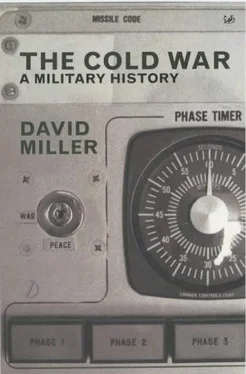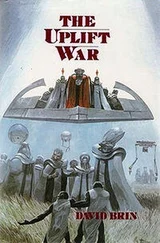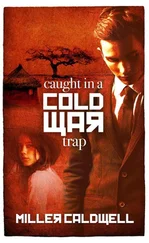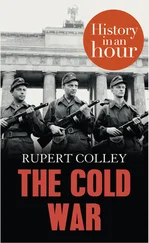Sudetenland, 5, 7
Suez crisis (1956), 26, 34, 37, 58, 223
Sun Tzu, 320, 387
Supreme Headquarters Allied Powers Europe (SHAPE), 47
surface-to-air missiles (SAMs), 135, 286–9, 314
Suslov, Mikhail, 58
Sweden: and Nordic pact, 14–15; declines NATO membership, 19–20; civil defence, 153; battle tank, 273
Switzerland: civil defence, 153
tanker aircraft, 134, 415
tanks (battle): British, 157, 259, 264, 268–9, 272–4, 435; characteristics and performance, 257–61; Soviet, 258–9, 262–5, 268, 272–4, 435–6; defence against, 259–61; US, 259, 265–8, 271–2, 435; fire-control systems, 260–1; armour and defence, 261–2, 270; propulsion and engines, 262; French, 265, 270, 435; NATO, 265–72; West German, 265–73, 435; Swedish, 273; costs, 274
Thatcher, Margaret, 386
thermal radiation (nuclear), 74–5
Thor missile, 96, 103
Thorez, Maurice, 21
Thresher (US submarine), 185
throw weight (missile payload), 92–3
Titan missile, 97, 104, 106, 160
Tito, Josip Broz: takes power, 8; independence of Soviet Union, 57, 64
Togliatti, Palmiro, 9
Tokyo: bombed (1945), 74, 373–4
Tomahawk cruise missile, 113, 186
Tongking, Gulf of, 209
transient radiation effects on electronics (TREE), 77
triad (strategic concept), 88
Trident submarine missile system, 112–15, 120, 140, 141, 158
Trieste, 9
‘tripwire’ strategy, 27 & n; replaced by ‘flexible response’, 27, 237, 365
Triton submarine-launched-cruise-missile programme, 111
Truman, Harry S.: supports Brussels Treaty, 13; 1948 election victory, 18–19; and North Atlantic Treaty, 18
Tsushima, battle of (1905), 175n
Turkey: membership of NATO, 22, 25, 49; hostility to Greece, 26, 37; occupies northern Cyprus, 37; sea supplies to, 163; navy, 169; submarines, 191, 195; marines, 227; airborne troops, 242; aircraft, 308; battlefield nuclear weapons in, 350
‘twin-track’ (diplomatic/military) approach, 42
U-2 spy plane, 26, 364
U-boats see submarines
Ukraine: independence (1991), 67
Union of Soviet Socialist Republics see Soviet Union
United Kingdom: post-war status, 4, 16–17, 136; and Malaya ‘emergency’, 9–10; signs Dunkirk Treaty, 10–11; in Brussels Treaty, 11; borrows from USA, 16; relations with USA, 16–17; opposition to missile deployment, 42; command links with USA, 46; controls own land and air defences, 48; and naval command, 48–9, 51, 164; as NATO base, 51; nuclear testing, 80–1, 137, 405; wartime experience, 86; as nuclear-target reserve, 91; miniature submarines (‘X’ craft), 121n, 194; strategic bombers, 124–5, 131, 133, 136–9, 416–17; Strategic Air Command bases in, 125, 133; as nuclear power, 136–41; land-based missiles, 139–40; submarine programme, 140–1, 188–9, 193–4, 418; civil defence, 152–3; naval strength, 164, 171–2, 213; aircraft carriers, 196, 202–4; surface warships, 213–15; in Falklands War, 214–15; and mine warfare, 221–2; and amphibious warfare, 223; marines, 226; and central-European strategy, 231; regular army, 232; army in Europe, 234–5; airborne troops, 242; mobilization, 243–4; logistical problems, 246–7; deployment of forces, 248; battle tanks, 257, 259, 265, 268–9, 272–4, 435; armoured personnel carriers, 280; field artillery, 283, 437; air-defence missiles, 287, 290; air-defence control, 298; air force (RAF) in Germany, 299–300; fighter and attack aircraft, 306–7; and outbreak of 1914 war, 326–7; and military organization in Berlin, 334–5; battlefield nuclear weapons, 354; JIGSAW studies on effects of nuclear warfare, 368–70, 372–3, 375; procurement and financial problems, 380–2
United Kingdom Warning and Monitoring Organization (UKWMO), 152
United Nations High Commissioner for Refugees, 6
United States of America: post-war power, 4; observes Brussels Treaty, 12–13; and Nordic pact, 15; European garrisons and involvement, 16; relations with UK, 16–17; and formation of NATO, 17–22; forces relocated after French withdrawal from NATO, 35; in Vietnam War, 39, 135, 235; and missile deployment, 41–3; command links with UK, 46; in NATO command structure, 46–51; and naval command, 48; nuclear testing, 80–1, 405; deterrence strategy, 84–6, 366–7; nuclear planning, 87–90; nuclear targets in, 91; ICBM programme, 95–8, 104–5, 364, 422–4; submarine-based-missile threat to, 110; and UK nuclear weapons, 136–7, 139–40; targeted by China, 147; civil defence, 149, 151; adopts European aircraft and equipment, 210–11, 381; and central-European strategy, 231; abolishes conscription, 232, 235; army in Europe, 235–6, 238–40, 248; airborne troops, 241–2; mobilization and transport problems, 244–5, 247; battle tanks, 259, 265–8, 271–2, 435; and infantry mobility, 275–8; field guns, 283; air-defence missiles and guns, 286–7, 290–1; and Berlin incidents, 339–41; battlefield nuclear weapons, 350–3, 438–9; presidential control of use of nuclear weapons, 357; nuclear strategy, 363–7, 441–2; effects of Soviet nuclear attacks on, 369, 373–4; procurement and financing, 380–2; land-based missiles, 406; sea-launched ballistic missiles, 409; strategic missiles, 422–4
United States Air Force (USAF): ICBMs, 95–7, 104–5; strategic bombers, 99, 122, 124–7, 380, 413; in NATO, 300; fighter and attack aircraft, 303–5; see also Strategic Air Command
United States Marine Corps (USMC), 224–5, 304–5, 381
United States Navy: submarines, 113–15, 185–7, 191, 409–10; aircraft carriers, 163, 196–202; strength and role, 163–6, 173, 176; surface warships, 208–12; battleships, 218, 225; and mine warfare, 220–2; and amphibious warfare, 223; attack aircraft, 304–5; and Berlin contingency plans, 337; carrier air wing, 431
United States Sixth Fleet: in Mediterranean, 49
United States (US carrier), 197, 199
V-1 cruise missile (German), 82, 84n, 95, 110–11, 131, 351
V-2 rocket (German) see A-4 rocket
V-force bombers (UK), 131, 133, 136–9
Vandenberg, Arthur, 21
Vandenberg Air Force Base, California, 157
Vienna see Conventional Armed Forces in Europe talks
Viet Minh, 9, 34
Vietnam: US involvement in, 39, 235; US bombing in, 135; US navy and, 165, 209; as Soviet ally, 174; see also Indo-China
Vincennes (US cruiser), 210
Wałesa, Lech, 67
Walker spy ring, 178
Walter, Dr Helmuth, 184, 193–4
warheads (nuclear), 91–4; enhanced-radiation, 75, 77, 350, 385–6
Warsaw Pact: formed (1955), 26, 54–5; forces invade Czechoslovakia (1968), 28, 38–40, 59–61, 253, 322, 325; troop reductions (1989), 31; command structure, 55–6; Soviet troop deployment, 55–6; collapse, 66–7; civil-defence measures, 151; navies, 174–83; submarines, 195; European attack strategy and plans, 237, 358–62, 375; deployment of forces in Europe, 250–6; airborne forces, 254–6; battle tanks, 258–9, 262–5, 268, 272–4, 435; air forces, 312–16; and NATO alert systems and plans, 320–6; preparations for war, 324–7; battlefield nuclear weapons (tactical), 349, 353–4, 383; financing, 379; text of Treaty, 398–400; appointments and commanders, 404
warships (surface), 208–18
Weinberger, Caspar, 84
West Germany (Federal Republic of Germany): rearmament, 25, 54–5; joins Brussels Treaty, 26; membership of NATO, 26, 54–5, 236; 1970 Soviet Treaty, 28; Polish Treaty (1970), 28; admitted to UN, 29; and NATO command structure, 50; civil defence, 153; naval role, 167, 169; submarines (U-boats), 169, 194–5; armed forces, 231, 233–4; and NATO defence strategy, 237–40; airborne troops, 242; mobilization, 244–5; and refugee problem, 246; deployment of forces, 248; battle tanks, 265–73, 381, 435; infantry carriers, 279; artillery, 283, 437; air-defence missiles, 287; air force and aircraft, 298–9, 308–9; set up, 330; contributes to costs of Berlin occupation, 346; battlefield nuclear weapons in, 350; and Warsaw Pact attack threat, 359–62; effects of nuclear warfare in, 376–7; see also Germany
Читать дальше












